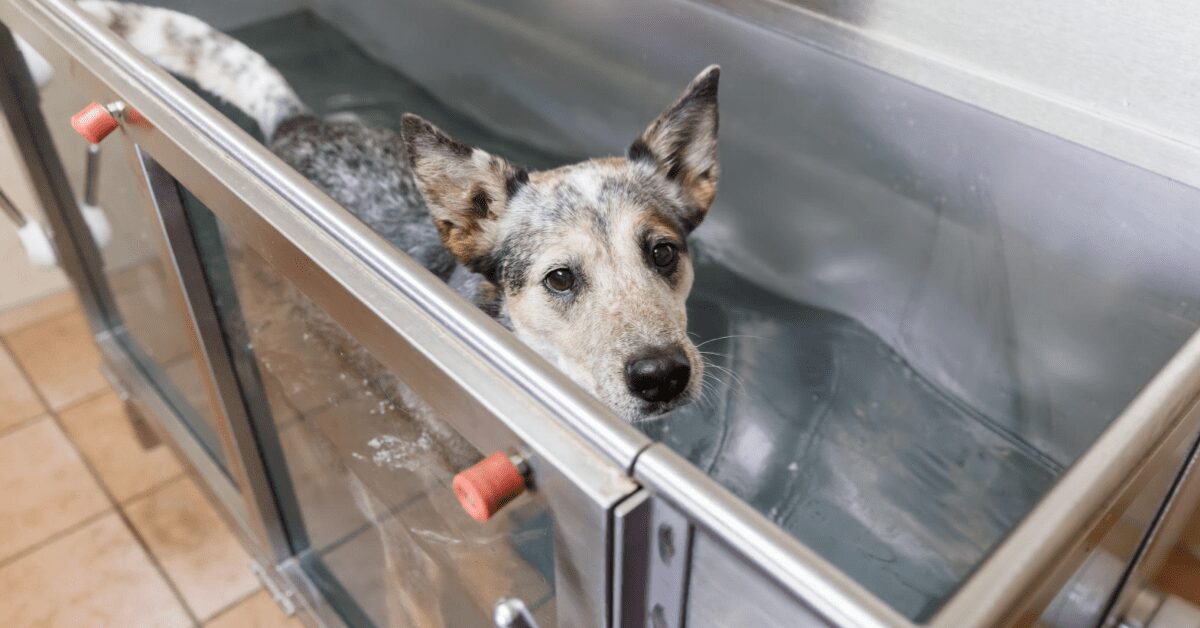Key Points
- Hydrotherapy is a great physical therapy for dogs needing low-impact exercise to lose weight, rehabilitate an injury, or support aching joints.
- Your dog can experience the benefits of hydrotherapy at home or at a treatment center.
- Hydrotherapy can be used to treat arthritis, hip dysplasia, intervertebral disc rupture, and more.
Humans have long enjoyed various types of hydrotherapy, including water aerobics, swimming, saunas, mineral baths, and more. But what about hydrotherapy for dogs?
Hydrotherapy can be an excellent treatment to improve your furry friend’s mobility and overall well-being. Water resistance helps boost blood circulation and build muscle mass in a low-impact environment, making it a great therapy for those suffering from hip dysplasia, arthritis, obesity, and other dog health conditions.
So, should your dog try it? Let’s consider why hydrotherapy may be the way to go!
What is hydrotherapy for dogs?
Also known as water or aquatic therapy, hydrotherapy is a low-impact physical therapy treatment that uses the benefits of water to help dogs recover from various health conditions. Dr. Jamie Whittenburg (DVM) explains, “Hydrotherapy can come in the form of swimming in a pool or walking on underwater treadmills and is used for exercise as well as rehabilitation. This exercise modality can help improve strength, increase range of motion, and build endurance.”
Take the story of five-year-old golden retriever Max, for example. Max – a patient of Dr. Patrik Holmboe, head veterinarian at Cooper Pet Care – suffered from advanced hip arthritis that limited his ability to fetch and enjoy walks with his parents. Despite weight management and prescription medication, Max still struggled to get around, prompting Dr. Holmboe to prescribe weekly sessions of underwater treadmill therapy. Max loved the treats and attention he received during his hydrotherapy treadmill workouts. In addition to becoming a happier pooch, Max showed significant improvements in mobility, flexibility, and comfort level.
Benefits of hydrotherapy for dogs
Hydrotherapy for dogs can provide a multitude of benefits, such as:
- Improve strength and range of motion after surgery or injury
- Support joints of dogs with arthritis, hip dysplasia, or a joint pain flare-up
- Help improve overall blood circulation, which can benefit dogs with heart disease or lymphatic disorders
- Help overweight dogs shed some pounds
- Provide the mental and physical stimulation dogs need to stay happy!
Hydrotherapy can also be a great way to lift your furry friend’s spirits during a lengthy recovery, especially if you have an energetic pup who doesn’t know the meaning of “take it easy.”
For instance, Dr. Thomas Doyne (DVM, MS) was caring for a hyperactive hound named Meg, who loved to run through the woods at top speed and ended up in the ditch with a broken leg. “Resting and physiotherapy didn’t seem to help much with Meg’s energetic personality, and pain medication was the only thing that kept her calm,” recalls Dr. Doyne. “That’s when we thought outside the box and decided to give hydrotherapy a shot to reduce weight on her leg and help her build strength and muscle mass.” Over the course of therapy, he measured Meg’s range of motion with gait analysis and found the treatment had worked wonders.
The accessibility of hydrotherapy is also a major advantage, as many dogs can participate regardless of age, size, or physical condition.
Hydrotherapy can also help treat:
- ACL recovery
- Arthritis
- Muscle atrophy
- Paralysis
- Obesity
- Hip or elbow dysplasia
- Cruciate ligament rupture
- Neurological conditions
- Intervertebral disc rupture slipped disc
How hydrotherapy for dogs works
Typically, hydrotherapy begins with a visit to the veterinarian and is not the first — or only — course of treatment.
Dr. Iram Sharma, DVM, a veterinary consultant for Pupvine.com, treated an overweight labrador suffering from muscle strains, post-traumatic arthritis, and minor hip luxation due to excessive exercise. In addition to a change in diet, joint supplements, anti-inflammatory medication, pain relievers, and vitamin B12, hydrotherapy was chosen to improve muscle mass and weight loss. After six weeks of 20-minute hydrotherapy sessions, Dr. Sharma noted significant muscle mass improvement in the affected hip region, along with a reduction in limping and improved trotting.
Remember Max, the golden retriever? Here’s how the treatment worked for him, according to Dr. Holmboe:
“We use a treadmill that is partially submerged, with the water level coming up to about the level of Max’s chest. The buoyancy of the water supports the dog’s body, reducing stress on his joints and allowing him to move around more freely. The underwater treadmill provides controlled exercise, helping to move and strengthen his muscles in a very low-impact way.”
Depending on your dog’s case, their hydrotherapy treatment can look similar or different from these stories. Your veterinarian should be able to help you come up with a plan that works for your dog’s unique situation.
Types of hydrotherapy for dogs
Several types of hydrotherapy are available for dogs, including:
- Swimming pool sessions
- Underwater treadmill workouts
- Immersion therapy in a heated whirlpool
Each type of therapy has its own set of benefits and can be tailored to your dog’s specific needs.
“Underwater treadmill therapy, for example,” explains Dr. Holmboe, “is often used for dogs with joint problems, while aquatic therapy is better suited for dogs recovering from surgery or with neurological conditions.”
Hydrotherapy doesn’t have to occur in a professional setting, either. Recreational hydrotherapy can be done in a swimming pool or even a bath, depending on the size of your dog. But keep in mind: not all doggies are natural swimmers! Be sure to keep a close watch on your pooch when they first dive in.
Making a hydrotherapy plan with your veterinarian
If you think hydrotherapy is the right treatment for your dog, talk to a veterinarian. “The first step is to speak with your veterinarian about the availability of such a therapeutic modality in your area and – if necessary – obtain a referral,” says Dr. Whittenburg. “The American Association of Rehabilitation Veterinarians is a great resource as well.”
A vet or certified hydrotherapist can determine whether your pup can benefit from hydrotherapy and guide them through water exercises at a rehabilitation center.
According to Dr. Holmboe, “Whether hydrotherapy is a good treatment for a dog depends on several factors, including the underlying condition, the severity of the symptoms, and the overall health and temperament of the dog. Additional factors such as the pet’s age, breed, and medical history will all be considered in making a decision about whether hydrotherapy is a good option.”
While hydrotherapy can be an immense help in building muscle and endurance, it shouldn’t be the sole treatment for inflammation and pain. The best rehabilitation plans are individualized for each dog with a combination of treatments. Hydrotherapy can be a lengthy therapy, spanning many weeks or months, and it can be costly without pet insurance – so these factors must also be considered.
Tip: Whether your pooch is a senior dog or recovering from an injury, hydrotherapy can be a great way to improve their mobility. Pumpkin Dog Insurance plans can help pay for alternative therapies like hydrotherapy when used to treat a covered condition.
What does hydrotherapy for dogs do?
Hydrotherapy can benefit dogs in many ways, such as increasing mobility, building strength, reducing pain, and improving blood circulation. The water provides a non-weight environment for movements that would not be possible on land due to injury, weight, or other pain. This is especially helpful to dogs suffering from joint problems and obesity.
How long will my dog need to go to hydrotherapy?
Treatment time will depend on your dog’s individual needs. Some dogs may need treatment for six months to one year until their condition improves, whereas other dogs may benefit from weekly therapy sessions for their entire lives.
How much does hydrotherapy cost?
Costs vary, but the average session is between $35 and $50.
Can I do hydrotherapy at home?
Recreational hydrotherapy can be done in a kiddie pool, swimming pool, or larger body of water. But not all dogs can swim, so watching your pup is important.
- Frequently Asked Questions. (2022). National Association of Registered Canine Hydrotherapists. Accessed on January 24, 2023.
- Benefits of Hydrotherapy (Aquatic Therapy) For Dogs. (2022). West Chester Veterinary Medical Center. Accessed on January 24, 2023.




